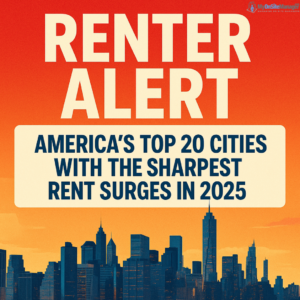As we approach the middle of 2025, renters across the United States are feeling the sting of rising rental prices. Whether you’re looking for your first apartment, renewing a lease, or relocating for work, the cost of renting has never been more unpredictable. A recent report by 24/7 Wall St., based on research from Construction Coverage, highlights the 20 U.S. cities where rent has increased the most this year — and some of the numbers are staggering.
For tenants, landlords, and policymakers alike, these figures shed light on broader housing challenges that many communities are facing.
What’s Fueling These Steep Rent Hikes?
Several key factors are contributing to these dramatic increases:
Population Growth & Remote Work Expansion
Many smaller and mid-sized cities — such as Bozeman, Boise, and Helena — have seen a surge of new residents, particularly remote workers seeking a better quality of life. The pandemic fundamentally shifted where people choose to live, leading to increased demand in places that previously had more affordable housing markets.
Limited Housing Supply
In many cities, construction of new rental housing has failed to keep up with population growth. Stringent zoning laws, high material costs, labor shortages, and regulatory delays continue to hinder housing development, creating a severe supply-demand imbalance.
Higher Operating Costs for Landlords
Landlords are facing rising costs for property taxes, insurance, utilities, repairs, and maintenance. Many are passing these costs along to tenants in the form of higher rents.
Economic Growth in Key Industries
Booms in industries such as technology, healthcare, manufacturing, and energy have driven job growth in many of these cities. As more workers move in to take advantage of job opportunities, competition for housing intensifies, pushing rental prices upward.
The Top 20 U.S. Cities Where Rent Increased the Most in 2025
Here’s a closer look at the cities leading the nation in rent increases:
| Rank | City, State | Year-over-Year Rent Increase |
|---|---|---|
| 1 | Bozeman, MT | +37.4% |
| 2 | Boise City, ID | +32.1% |
| 3 | Helena, MT | +29.5% |
| 4 | Knoxville, TN | +25.0% |
| 5 | Pensacola, FL | +24.6% |
| 6 | Daytona Beach, FL | +21.7% |
| 7 | Idaho Falls, ID | +18.8% |
| 8 | Twin Falls, ID | +18.7% |
| 9 | Pinehurst, NC | +18.4% |
| 10 | Syracuse, NY | +18.0% |
| 11 | Harrisonburg, VA | +17.9% |
| 12 | Kingsport, TN | +17.7% |
| 13 | Rochester, MN | +17.3% |
| 14 | Midland, TX | +17.0% |
| 15 | Auburn, AL | +16.8% |
| 16 | Prescott Valley, AZ | +16.7% |
| 17 | Bangor, ME | +16.5% |
| 18 | Rapid City, SD | +16.4% |
| 19 | Jacksonville, NC | +16.2% |
| 20 | Albany, GA | +16.0% |
Spotlight on Key Cities
Bozeman, MT (+37.4%)
Bozeman has seen the largest rent increase nationwide, driven by an influx of high-earning remote workers and limited new housing construction. The city’s natural beauty and growing tech scene have made it a magnet for professionals fleeing larger metro areas.
Boise, ID (+32.1%)
Boise has become one of the fastest-growing cities in the country, attracting new residents for its strong job market and relatively lower cost of living (compared to larger West Coast metros). However, limited housing stock is quickly driving up rental prices.
Helena, MT (+29.5%)
Helena is facing similar pressures as Bozeman, with strong demand and limited supply pushing rents up significantly. This trend is particularly challenging for long-term residents who are now facing much higher housing costs.
Knoxville, TN (+25.0%)
Knoxville’s expanding healthcare, education, and manufacturing sectors are drawing new residents, adding further strain on the city’s rental market.
Pensacola, FL (+24.6%)
Pensacola has long been a popular destination for both tourists and retirees. The city’s rapid growth, combined with limited new construction, is driving up rent prices at one of the fastest rates in Florida.
The Broader Impact on Renters
For millions of renters across the country, these increases aren’t just numbers — they’re having real financial consequences:
-
Affordability Crisis: Many households are spending a larger share of their income on rent, often exceeding the recommended 30% threshold for housing costs.
-
Displacement Risks: Longtime residents may be forced to relocate to more affordable areas as rents continue to climb.
-
Fewer Affordable Options: In many of these cities, affordable housing units are becoming increasingly scarce, making it difficult for low- and middle-income renters to find suitable homes.
What Can Be Done?
While rent increases are influenced by many factors, several policy solutions could help stabilize prices over time:
-
Expand Housing Development: Streamlining zoning laws, reducing permitting delays, and incentivizing developers to build more multi-family housing can help increase supply.
-
Invest in Affordable Housing: Federal, state, and local governments can provide subsidies and tax credits to encourage the construction of affordable housing units.
-
Strengthen Tenant Protections: Rent control policies, eviction protections, and tenant assistance programs can help renters stay in their homes during periods of rapid rent increases.
-
Encourage Smart Growth: Cities can adopt policies that encourage higher-density development, mixed-use zoning, and better urban planning to meet future housing demand.
Looking Ahead
With the rental market remaining volatile, both renters and landlords will need to navigate ongoing uncertainty. For renters, this means being proactive:
-
Monitor local rent trends
-
Understand your lease terms
-
Know your rights as a tenant
-
Explore long-term leases or fixed-rate agreements where possible
At the same time, policymakers and real estate professionals must work together to address the root causes of rising rents and ensure that housing remains accessible to all income levels.
Source:
The Top 20 Cities Where Rent Has Increased the Most This Year
24/7 Wall St., March 18, 2025
👉 Read the full article here

